Motorola Droid RAZR Review - A Better Clad Bionic
by Brian Klug on December 16, 2011 2:01 AM EST- Posted in
- Smartphones
- Droid
- LTE
- 4G
- Motorola
- Android
- Mobile
- Droid RAZR
- motorola droid RAZR
Battery Life
I still think that when we’re reviewing a 4G LTE device that battery life is the main concern, and with a sealed internal battery this is an even more relevant point than it would be otherwise. I started the Bionic review out with a look at battery life first, and think the same approach makes sense for the RAZR. As I mentioned before, the RAZR has a 6.7 Whr internal battery which makes use of Motorola’s new higher voltage Li-Ion chemistry, just like we saw in the Bionic.
Motorola also sent us all the goodies to go along with the RAZR, including the Lapdock 100, car windshield mount, VGA adapter, and an extra external 6.9 Whr battery. More on those accessories in a moment, for now let's just talk about the battery.
Since the battery for the RAZR is sealed inside, there’s no way to go the traditional extended battery route, and thus this external battery which connects using microUSB is the only viable option to extend your electron tank. The external battery charges using a microUSB port on its side and can charge up to two devices at the same time.
One using the microUSB connector on a rubberized cable that folds into the opposite side, the other using the female USB type A connector at the top. I used the external charger to juice up the RAZR and another device at the same time to much success. Of course, using a big external battery to simultaneously charge a battery and power the RAZR incurs some overhead.
To measure how good the RAZR is at sipping juice, we turned to our standard suite of battery life tests. The first loads through a dozen or so pages over cellular data and WiFi with the display constantly on and set to a brightness of 200 nits using the stock browser.

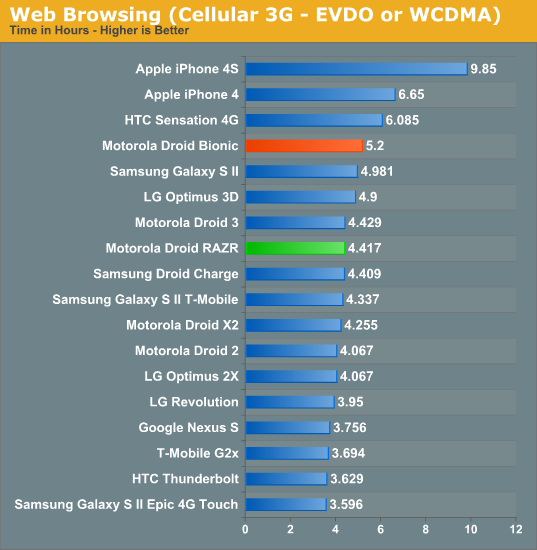
In the cellular browsing department, the RAZR unsurprisingly performs very close to the Bionic, but comes in just behind in spite of having a slightly larger battery. It’s pretty easy to point out the sources of increased battery drain on the RAZR versus Bionic, and that’s both inclusion of AMOLED (virtually all the webpages in our testing suite have white backgrounds), and a higher CPU clock, though admittedly most of the time the CPU is in an idle state. The other parts of the equation again remain the same - the RAZR has the same cellular basebands and a similar family PMIC (power management IC).
Using the external battery gives you another 2.5 hours of charge in our LTE test, which isn’t a doubling, but still a respectable boost. As predicted, you end up losing some of that charge on the external battery to overhead, but it isn’t dramatic. I didn’t measure how much of a gain using the external battery on EVDO nets you, but you can safely bet the same 1.83 multiplier applies.
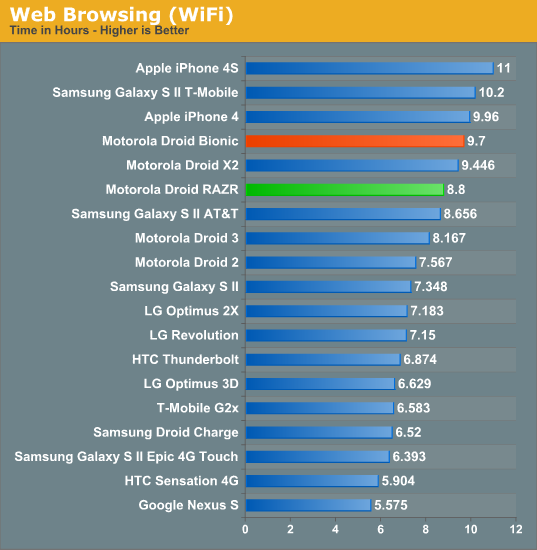
This trend where the RAZR lags the Bionic in our battery life testing carries on to the WiFi web browsing test as well - the two include the same TI WL1285 WLAN combo chip.
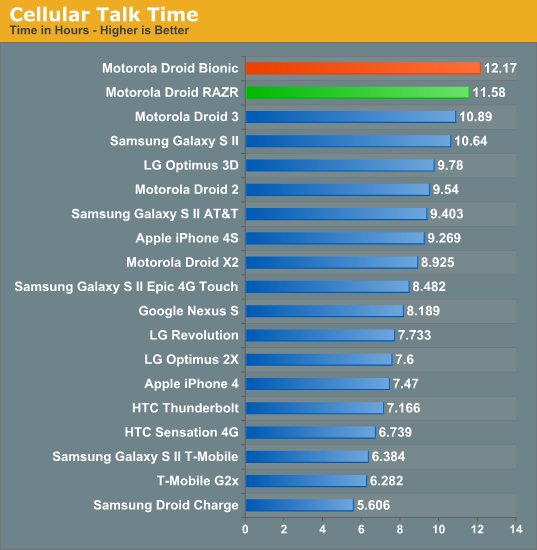
Call testing time likewise puts the RAZR just behind the Bionic. As a reminder, calls on Verizon still happen over 1x on the MDM6600.
I’m starting to put more stock in our WiFi hotspot battery life test, which has four of our normal page loading tabs open and a 128 kbps MP3 streaming radio instance from smoothbeats.com going. This keeps the baseband and WiFi stacks up and also relies on the CPU for routing network traffic through a NAT, and the display is off.
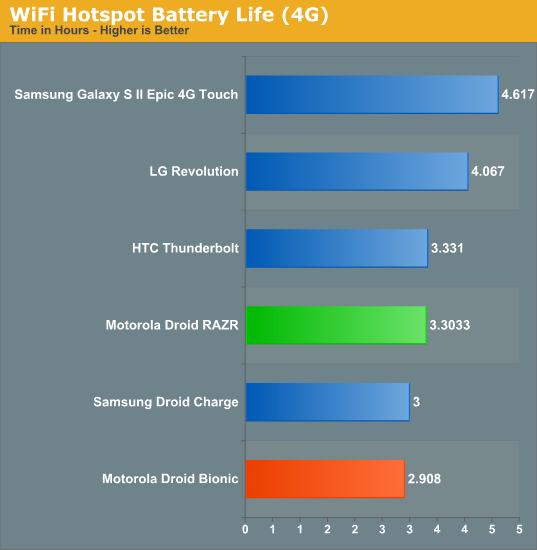

Here the RAZR surprisingly ousts the Bionic (despite testing being done in the exact same location and signal characteristics) by a little over a half hour.
So in the battery department there isn’t much to talk about with respect to the RAZR except to note that it’s very comparable to the Bionic owing to - again - being based on essentially the same hardware platform. The difference we do see is largely a result of adding a Super AMOLED Advanced display and higher peak CPU clock.
If you’re not near a charger or unwilling to go for the external battery, our guidance remains much the same as it did when we first started looking closely at 4G LTE handsets - wait for 28nm SoCs and basebands in 2012. That said, it’s absolutely possible to make it through a day with the internal battery, it just depends on what your daily use patterns are.


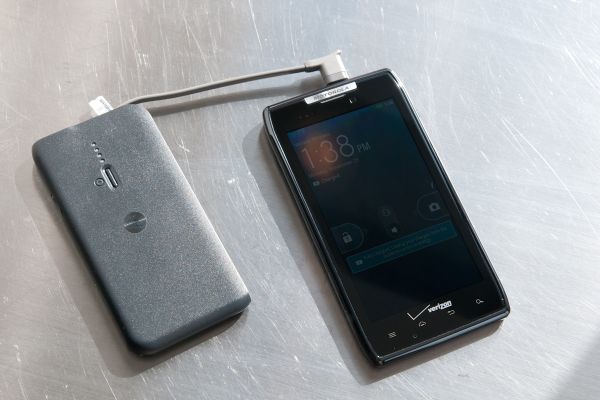
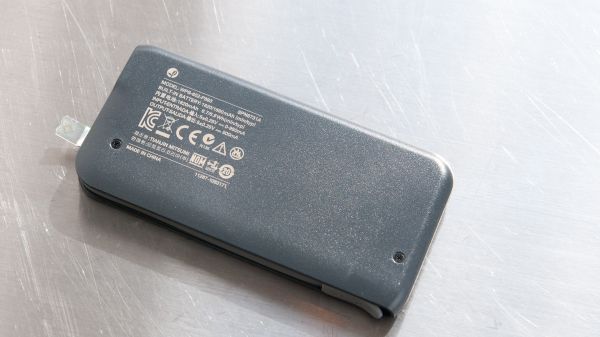














76 Comments
View All Comments
Devo2007 - Friday, December 16, 2011 - link
Brian Klug - Friday, December 16, 2011 - link
Motorola a few times made specific note that their skin isn't called Blur, even though in build.prop and relevant places, it's called "Blur." I guess it all just boils down to semantics. :)-Brian
yas69 - Friday, December 16, 2011 - link
S2 benchmark values are different with November/December stock firmware.I get 1130 on vellamo with recent S2 firmware. Sunspide/Browsermark values are better than also higher than Razr.
Brian Klug - Saturday, December 17, 2011 - link
What ROM and browser are you tesing in? I can't get any higher than what's in the article on our UK SGS2 with the latest ROM from Kies.-Brian
yas69 - Sunday, December 18, 2011 - link
I9100XWKK2 / I9100XWKL1 both perform better than previous versions.yas69 - Monday, December 19, 2011 - link
sorry.I9100XWKK2 (2.3.6)
Vellamo = 1161
sunspider = 1980
browsermark = 78014
lemmo - Friday, December 16, 2011 - link
Thanks for the review, but do you have any more info on audio quality in terms of music playback? You are saying that it is an improvement over the Bionic but how does it compare to other phones like SGS2 and iPhone?Your detailed review of audio quality on the SGS2 was really helpful and I thought you were going to include this testing methodology on all smartphone reviews from now on...?
kishorshack - Friday, December 16, 2011 - link
Even i expect the same thing brian klug it would be awesome if you update this review someday :)Brian Klug - Saturday, December 17, 2011 - link
We're definitely going to do some more in-depth audio testing, it's something new to me but we've finally got the hardware and methodology, just have to interpret results. I did link to the RMAA runs from here for your own perusal, which we're going to talk a bit more about in the Galaxy Nexus piece.-Brian
lemmo - Saturday, December 17, 2011 - link
Thanks Brian that's great news :)As I asked in my comment below, will you do a comparative audio test with other phones when you do the Nexus review? The test results for just the phone you're testing don't mean much unless we know how they compare. Cheers